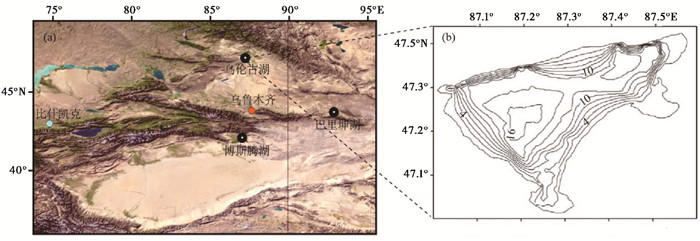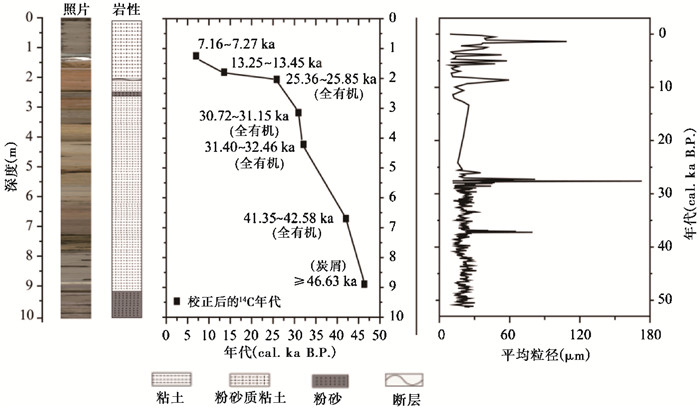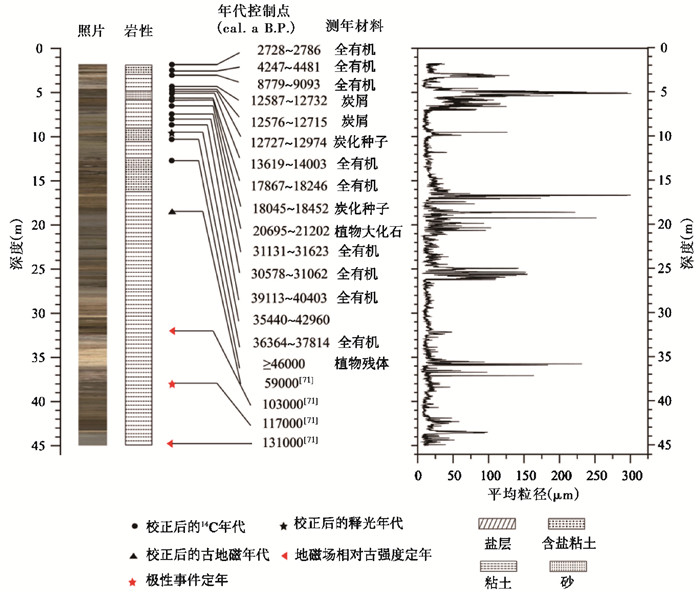| [1] |
Jouzel J, Lorius C, Petit J R, et al. Vostok ice core:A continuous isotope temperature record over the last climatic cycle (160, 000 years)[J]. Nature, 1987, 329(6138): 403. |
| [2] | |
| [3] | |
| [4] | |
| [5] |
Martinson D G, Pisias N G, Hays J D, et al. Age dating and the orbital theory of the ice ages:Development of a high-resolution 0 to 300, 000-year chronostratigraphy[J]. Quaternary Research, 1987, 27(27): 1-29. |
| [6] |
Lisiecki L E, Raymo M E. A Pliocene-Pleistocene stack of 57 globally distributed benthic δ18O records[J]. Paleoceanography, 2005, 20(1): 1-16. DOI:10.1029/2004PA00107 |
| [7] |
Jouzel J, Masson-Delmotte V, Cattani O, et al. Orbital and millennial Antarctic climate variability over the past 800, 000 years[J]. Science, 2007, 317(5839): 793-797. DOI:10.1126/science.1141038 |
| [8] |
North Greenland Ice Core Project Members. High-resolution record of Northern Hemisphere climate extending into the last interglacial period[J]. Nature, 2004, 431(7005): 147-151. |
| [9] |
刘东生, 等. 黄土与环境[M]. 北京: 科学出版社, 1985: 1-12.
Liu Tungsheng, et al. Loess and Environment[M]. Beijing: Science Press, 1985: 1-12.
|
| [10] |
杨石岭, 丁仲礼. 黄土高原黄土粒度的空间变化及其古环境意义[J]. 第四纪研究, 2017, 37(5): 934-944. Yang Shiling, Ding Zhongli. Spatial changes in grain size of loess deposits in the Chinese Loess Plateau and implications for palaeoenvironment[J]. Quaternary Sciences, 2017, 37(5): 934-944. |
| [11] | |
| [12] | |
| [13] | |
| [14] |
Wang Y J, Cheng H, Edwards R L, et al. A high-resolution absolute-dated. record of the East Asian monsoon from 11, 000 to 75, 000 years B. P. from Hulu cave, China[J]. Science, 2001, 294(5550): 2345-2348. |
| [15] | |
| [16] | |
| [17] |
Cai Y J, Cheng H, An Z S, et al. Large variations of oxygen isotopes in precipitation over south-central Tibet during marine isotope stage 5[J]. Geology, 2010, 38(3): 243-246. |
| [18] | |
| [19] | |
| [20] |
Regattieri E, Zanchetta G, Drysdale R N, et al. A continuous stable isotope record from the penultimate Glacial Maximum to the last interglacial(159-121 ka) from Tana Che Urla Cave (Apuan Alps, central Italy)[J]. Quaternary Research, 2014, 82(2): 450-461. |
| [21] | |
| [22] |
Bar-Matthews M, Ayalon A, Gilmour M, et al. Sea-land oxygen isotopic relationships from planktonic foraminifera and speleothems in the Eastern Mediterranean region and their implication for paleorainfall during interglacial intervals[J]. Geochimica et Cosmochimica Acta, 2003, 67(17): 3181-3199. DOI:10.1016/S0016-7037(02)01031-1 |
| [23] |
孙喜利, 杨勋林, 史志超, 等. 石笋记录的西南地区MIS 4阶段夏季风的演化[J]. 第四纪研究, 2017, 37(6): 1370-1380. Sun Xili, Yang Xunlin, Shi Zhichao, et al. The evolution of summer monsoon in Southwest China during MIS 4 as revealed by stalagmite δ18O record[J]. Quaternary Sciences, 2017, 37(6): 1370-1380. |
| [24] |
王权, 汪永进, 刘殿兵, 等. DO3事件的湖北神农架高分辨率年纹层石笋记录[J]. 第四纪研究, 2017, 37(1): 108-117. Wang Quan, Wang Yongjin, Liu Dianbing, et al. The DO3 event in Asian monsoon climates evidenced by an annually laminated stalagmite from Qingtian cave, Mt. Shennongjia[J]. Quaternary Sciences, 2017, 37(1): 108-117. |
| [25] |
董进国, 赵侃, 沈川洲, 等. 黄土高原石笋记录的DO25季风增强事件[J]. 第四纪研究, 2016, 36(6): 1502-1509. Dong Jinguo, Zhao Kan, Shen Chuan-Chou, et al. Strong East Asian summer monsoon during the do 25 event recorded by an absolute-dated stalagmite from Dragon cave, Northern China[J]. Quaternary Sciences, 2016, 36(6): 1502-1509. |
| [26] | |
| [27] | |
| [28] |
张恩楼, 孙伟伟, 刘恩峰, 等. 末次冰盛期以来洱海沉积物元素碳同位素特征与区域植被组成变化[J]. 第四纪研究, 2017, 37(5): 1027-1036. Zhang Enlou, Sun Weiwei, Liu Enfeng, et al. Vegetation change reconstructed by a stable isotope record of elemental carbon from Lake Erhai, Southwest China since the Last Glacial Maximum[J]. Quaternary Sciences, 2017, 37(5): 1027-1036. |
| [29] |
韩鹏, 刘兴起. 内蒙古中东部查干淖尔湖流域7000年以来的气候演变[J]. 第四纪研究, 2017, 37(6): 1381-1390. Han Peng, Liu Xingqi. The climate evolution inferred from Chagan-Nuur in middle-east part of Inner Mongolia since the last 7000 years[J]. Quaternary Sciences, 2017, 37(6): 1381-1390. |
| [30] |
倪振宇, 王永波, 刘兴起. 青藏高原北部库赛湖自生碳酸盐稳定同位素记录的晚全新世气候组合特征[J]. 第四纪研究, 2016, 36(4): 961-969. Ni Zhenyu, Wang Yongbo, Liu Xingqi. Late Holocene climatic combination on the northern Tibetan Plateau based on stable isotope analysis of authigenic carbonate from Kusai Lake[J]. Quaternary Sciences, 2016, 36(4): 961-969. |
| [31] |
Li G Q, Jing M, Chen X M, et al. Environmental changes in the Ulan Buh Desert, southern Inner Mongolia, China since the Middle Pleistocene based on sedimentology, chronology and proxy indexes[J]. Quaternary Science Reviews, 2015, 128: 69-80. |
| [32] | |
| [33] |
Ellwein A L, Mahan S A, McFadden L D. New optically stimulated luminescence ages provide evidence of MIS 3 and MIS 2 eolian activity on Black Mesa, northeastern Arizona, USA[J]. Quaternary Research, 2011, 75(3): 395-398. |
| [34] |
Chen F H, Yu Z C, Yang M L, et al. Holocene moisture evolution in arid Central Asia and its out-of-phase relationship with Asian monsoon history[J]. Quaternary Science Reviews, 2008, 27(3-4): 351-364. DOI:10.1016/j.quascirev.2007.10.017 |
| [35] |
郑度. 中国生态地理区域系统研究[M]. 北京: 商务印书馆, 2008: 1-387.
Zheng Du. Study on the Eco-geographical Region System of China[M]. Beijing: The Commerial Press, 2008: 1-387.
|
| [36] | |
| [37] |
王苏民, 吉磊. 呼伦湖晚第四纪湖相地层沉积学及湖面波动历史[J]. 湖泊科学, 1995, 7(4): 297-306. Wang Sumin, Ji Lei. Sedimentology of Late Quaternary lacustrine deposits and history of lake level fluctuation in Hulun Lake[J]. Journal of Lake Sciences, 1995, 7(4): 297-306. |
| [38] | |
| [39] |
李冠华, 夏敦胜, 赵爽, 等. 新疆塔城地区黄土沉积的磁学特征及其对古环境变化的指示[J]. 中国沙漠, 2012, 32(6): 1565-1575. Li Guanhua, Xia Dunsheng, Zhao Shuang, et al. Magnetic properties and palaeoclimatic implication of the loess deposits in Tacheng, Northwest China[J]. Journal of Desert Research, 2012, 32(6): 1565-1575. |
| [40] | |
| [41] | |
| [42] |
王岳, 李育, 张成琦. 河西走廊东西段全新世古湖泊演化对比研究[J]. 第四纪研究, 2017, 37(3): 581-596. Wang Yue, Li Yu, Zhang Chengqi. The comparative study of paleolakes evolution between the eastern and western parts of the Hexi Corridor in Holocene[J]. Quaternary Sciences, 2017, 37(3): 581-596. |
| [43] | |
| [44] | |
| [45] |
符淙斌, 安芷生, 郭维栋. 我国生存环境演变和北方干旱化趋势预测研究(Ⅰ):主要研究成果[J]. 地球科学进展, 2005, 20(11): 1158-1168. Fu Congbin, An Zhisheng, Guo Weidong. Evolution of life-supporting environment in our nation and the predictive study of aridification in Northern China (Ⅰ):Main scientific issues and achievements[J]. Advances in Earth Science, 2005, 20(11): 1157-1167. |
| [46] |
陈发虎, 陈建徽, 黄伟. 中纬度亚洲现代间冰期气候变化的"西风模式"讨论[J]. 地学前缘, 2009, 16(6): 23-32. Chen Fahu, Chen Jianhui, Huang Wei. A discussion on the westerly-dominated climate model in mid-latitude Asia during the modern interglacial period[J]. Earth Science Frontiers, 2009, 16(6): 23-32. DOI:10.3321/j.issn:1005-2321.2009.06.003 |
| [47] |
黄伟, 陈建徽, 张肖剑, 等. 现代气候条件下降水变化的"西风模态"空间范围及其影响因子初探[J]. 中国科学:地球科学, 2015, 58(4): 379-388. Huang Wei, Chen Jianhui, Zhang Xiaojian, et al. Definition of the core zone of the "westerlies-dominated climatic regime", and its controlling factors during the instrumental period[J]. Science China:Earth Sciences, 2015, 58(5): 676-684. |
| [48] |
韩淑菴, 袁玉江. 新疆巴里坤湖35000年来古气候变化序列[J]. 地理学报, 1990, 45(3): 350-362. Han Shuti, Yuan Yujiang. The sequence of paleoclimatic variation of Balikun Lake of Xinjiang in the past 35000 years[J]. Acta Geographica Sinica, 1990, 45(3): 350-362. DOI:10.3321/j.issn:0375-5444.1990.03.011 |
| [49] |
闫顺, 穆桂金, 许英勤, 等. 新疆罗布泊地区第四纪环境演变[J]. 地理学报, 1998, 53(4): 332-340. Yan Shun, Mu Guijin, Xu Yingqin, et al. Quaternary environmental evolution of the Lop Nur region, China[J]. Acta Geographica Sinica, 1998, 53(4): 332-340. DOI:10.3321/j.issn:0375-5444.1998.04.007 |
| [50] | |
| [51] |
罗超, 杨东, 彭子成, 等. 新疆罗布泊地区近3.2万年沉积物的气候环境记录[J]. 第四纪研究, 2007, 27(1): 114-121. Luo Chao, Yang Dong, Peng Zicheng, et al. Climatic and environmental records in the sediment of the Luobei Billabong in Lop-Nur, Xinjiang in recent 32 ka[J]. Quaternary Sciences, 2007, 27(1): 114-121. DOI:10.3321/j.issn:1001-7410.2007.01.014 |
| [52] | |
| [53] | |
| [54] | |
| [55] |
于革, 薛滨, 王苏民, 等. 末次盛冰期中国湖泊记录及其气候意义[J]. 科学通报, 2000, 45(3): 250-255. Yu Ge, Xue Bin, Wang Sumin, et al. Lake-level records of China during the Last Glacial Maximum and its climatic implications[J]. Chinese Science Bulletin, 2000, 45(3): 250-255. DOI:10.3321/j.issn:0023-074X.2000.03.003 |
| [56] |
Zhao Y T, An C B, Mao L M, et al. Vegetation and climate history in arid Western China during MIS 2:New insights from pollen and grain-size data of the Balikun Lake, eastern Tien Shan[J]. Quaternary Science Reviews, 2015, 126: 112-125. |
| [57] | |
| [58] |
贾红娟, 汪敬忠, 秦小光, 等. 罗布泊地区晚冰期至中全新世气候特征及气候波动事件[J]. 第四纪研究, 2017, 37(3): 510-521. Jia Hongjuan, Wang Jingzhong, Qin Xiaoguang, et al. Climate and abrupt events record in the Lop Nur region from Late Glacial to the Middle Holocene[J]. Quaternary Sciences, 2017, 37(3): 510-521. |
| [59] |
蒋庆丰, 钱鹏, 周侗, 等. MIS-3晚期以来乌伦古湖古湖相沉积记录的初步研究[J]. 湖泊科学, 2016, 28(2): 444-454. Jiang Qingfeng, Qian Peng, Zhou Tong, et al. Preliminary research on ancient lacustrine sediments in Lake Ulungur in arid Central Asia since late MIS-3[J]. Journal of Lake Sciences, 2016, 28(2): 444-454. |
| [60] |
孙湘君, 杜乃秋, 翁成郁, 等. 新疆玛纳斯湖盆周围近14000年以来的古植被古环境[J]. 第四纪研究, 1994(3): 239-248. Sun Xiangjun, Du Naiqiu, Weng Chengyu, et al. Paleovegetation and paleoenvironment of Manas Lake, Xinjiang, N. W. China during the last 14000 year[J]. Quaternary Sciences, 1994(3): 239-248. DOI:10.3321/j.issn:1001-7410.1994.03.005 |
| [61] | |
| [62] | |
| [63] |
Ma Y Z, Zhang H C, Pachur H J, et al. Modern pollen-based interpretations of mid-Holocene paleoclimate (8500 to 3000 cal.BP) at the southern margin of the Tengger Desert, Northwestern China[J]. The Holocene, 2004, 14(6): 841-850. |
| [64] | |
| [65] | |
| [66] |
赵永涛, 安成邦, 陈玉凤, 等. 晚冰期以来乌伦古湖沉积物多指标高分辨率的古环境演化[J]. 干旱区地理, 2014, 37(2): 222-229. Zhao Yongtao, An Chengbang, Chen Yufeng, et al. A high-resolution climatic change since the late glacial age inferred from multi-proxy of sediments in Ulungur Lake[J]. Arid Land Geography, 2014, 37(2): 222-229. |
| [67] | |
| [68] |
Li G Q, Duan Y W, Huang X Z, et al. The luminescence dating chronology of a deep core from Bosten Lake(NW China) in arid Central Asia reveals lake evolution over the last 220 ka[J]. Boreas, 2017, 46(2): 264-281. |
| [69] |
Zhao Y T, An C B, Duan F T, et al. Consistent vegetation and climate deterioration from early to late MIS 3 revealed by multi-proxies(mainly pollen data) in north-West China[J]. Review of Palaeobotany and Palynology, 2017, 244: 43-53. DOI:10.1016/j.revpalbo.2017.04.010 |
| [70] |
Zhao J J, An C B, Huang Y S, et al. Contrasting Early Holocene temperature variations between monsoonal East Asia and westerly dominated Central Asia[J]. Quaternary Science Reviews, 2017, 178: 14-23. DOI:10.1016/j.quascirev.2017.10.036 |
| [71] | |
| [72] | |
| [73] | |
| [74] |
冯雪冰, 魏明建. 黄土样品重量对孢粉分析结果的影响[J]. 首都师范大学学报(自然科学版), 2015, 36(5): 60-64. Feng Xuebing, Wei Mingjian. Effects of weight to the pollen analysis results in the loess samples[J]. Journal of Capital Normal University(Natural Science Edition), 2015, 36(5): 60-64. DOI:10.3969/j.issn.1004-9398.2015.05.013 |
| [75] |
李育, 王乃昂, 许清海, 等. 中国北方第四纪孢粉提取方法研究[J]. 沉积学报, 2007, 25(1): 124-130. Li Yu, Wang Nai'ang, Xu Qinghai, et al. Investigation of Quaternary pollen and spores extraction methods in North China[J]. Acta Sedimentologica Sinica, 2007, 25(1): 124-130. DOI:10.3969/j.issn.1000-0550.2007.01.016 |
| [76] |
唐领余, 李春海, 安成邦, 等. 黄土高原西部4万多年以来植被与环境变化的孢粉记录[J]. 古生物学报, 2007, 46(1): 45-61. Tang Lingyu, Li Chunhai, An Chengbang, et al. Vegetation history of the western Loess Plateau of China during the last 40 ka based on pollen record[J]. Acta Palaeontologica Sinica, 2007, 46(1): 45-61. DOI:10.3969/j.issn.0001-6616.2007.01.003 |
| [77] | |
| [78] |
Imbrie J, Mcintyre A, Mix A. Oceanic response to orbital forcing in the Late Quaternary: Observational and experimental strategies[M]//Berger A, Schneider S, Duplessy J C. Climate and Geo-sciences. Netherlands: Springer, 1989: 121-164.
|
| [79] | |
| [80] |
Voelker A H L. Global distribution of centennial-scale records for Marine Isotope Stage(MIS) 3:A database[J]. Quaternary Science Reviews, 2002, 21(10): 1185-1212. DOI:10.1016/S0277-3791(01)00139-1 |
| [81] | |
| [82] | |
| [83] | |
| [84] | |
| [85] | |
| [86] | |
| [87] | |
| [88] |
Chen F H, Jia J, Chen J H, et al. A persistent Holocene wetting trend in arid Central Asia, with wettest conditions in the Late Holocene, revealed by multi-proxy analyses of loess-paleosol sequences in Xinjiang, China[J]. Quaternary Science Reviews, 2016, 146: 134-146. |
 2018, Vol.38
2018, Vol.38






